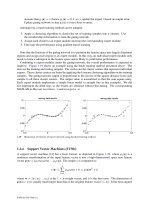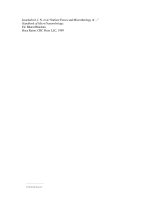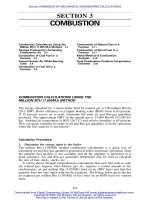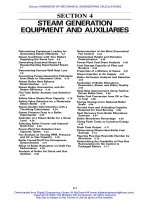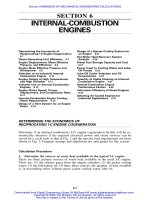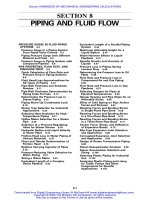Tài liệu HANDBOOK OF THE TREES OF NEW ENGLAND WITH RANGES THROUGHOUT THE UNITED STATES AND CANADA ppt
Bạn đang xem bản rút gọn của tài liệu. Xem và tải ngay bản đầy đủ của tài liệu tại đây (8.05 MB, 293 trang )
HANDBOOK OF THE
TREES OF NEW ENGLAND
WITH RANGES THROUGHOUT THE
UNITED STATES AND CANADA
BY
LORIN L. DAME, S.D.
AND
HENRY BROOKS
PLATES FROM ORIGINAL DRAWINGS
BY
ELIZABETH GLEASON BIGELOW
BOSTON, U.S.A.
GINN & COMPANY, PUBLISHERS
The Athenæum Press
1904
Copyright, 1901, by
Lorin L. Dame and Henry Brooks
ALL RIGHTS RESERVED
[Pg iii]
CONTENTS
PREFACE.
KEY TO THE TREES OF NEW ENGLAND.
LIST OF PLATES.
BOTANICAL AUTHORITIES.
ABBREVIATIONS.
TREES OF NEW ENGLAND.
PINOID. PINE FAMILY. CONIFERS.
SALICAC. WILLOW FAMILY.
JUGLANDAC. WALNUT FAMILY.
BETULAC. BIRCH FAMILY.
FAGAC. BEECH FAMILY.
ULMAC. ELM FAMILY.
MORAC. MULBERRY FAMILY.
MAGNOLIAC. MAGNOLIA FAMILY.
LAURAC. LAUREL FAMILY.
HAMAMELIDAC. WITCH HAZEL FAMILY.
PLATANAC. PLANE-TREE FAMILY.
POMAC. APPLE FAMILY.
DRUPAC. PLUM FAMILY.
LEGUMINOSỈ. PULSE FAMILY.
SIMARUBAC. AILANTHUS FAMILY.
ANACARDIAC. SUMAC FAMILY.
AQUIFOLIAC. HOLLY FAMILY.
ACERAC. MAPLE FAMILY.
TILIAC. LINDEN FAMILY.
CORNAC. DOGWOOD FAMILY.
EBENAC. EBONY FAMILY.
OLEAC. OLIVE FAMILY.
CAPRIFOLIAC. HONEYSUCKLE FAMILY.
APPENDIX.
GLOSSARY.
INDEX.
PREFACE.
There is no lack of good manuals of botany in this country. There still seems place for
an adequately illustrated book of convenient size for field use. The larger manuals,
moreover, cover extensive regions and sometimes fail by reason of their universality
to give a definite idea of plants as they grow within more limited areas. New England
marks a meeting place of the Canadian and Alleghanian floras. Many southern plants,
long after they have abandoned more elevated situations northward, continue to
advance up the valleys of the Connecticut and Merrimac rivers, in which they
ultimately disappear entirely or else reappear in the valley of the St. Lawrence; while
many northern plants pushing southward maintain a more or less precarious existence
upon the mountain summits or in the cold swamps of New England, and sometimes
follow along the mountain ridges to the middle or southern states. In addition to these
two floras, some southwestern and western species have invaded Vermont along the
Champlain valley, and thrown out pickets still farther eastward.
At or near the limit of a species, the size and habit of plants undergo great change; in
the case of trees, to which this book is restricted, often very noticeable. There is no
fixed, absolute dividing line between trees and shrubs. In accordance with the usual
definition, a tree must have a single trunk, unbranched at or near the base, and must be
at least fifteen feet in height.
Trees that are native in New England, or native in other sections of the United States
and thoroughly established in New England, are described and, for the most part,
figured. Foreign trees, though locally [Pg iv]established, are not figured. Trees may be
occasionally spontaneous over a large area without really forming a constituent part of
the flora. Even the apple and pear, when originating spontaneously and growing
without cultivation, quickly become degenerate and show little tendency to possess
themselves of the soil at the expense of the native growths. Gleditsia, for example,
while clearly locally established, has with some hesitation been accorded pictorial
representation.
The geographical distribution is treated under three heads: Canada and Alaska; New
England; south of New England and westward. With regard to the distribution outside
of New England, the standard authorities have been followed. An effort extending
through several years has been made to give the distribution as definitely as possible
in each of the New England states, and while previous publications have been freely
consulted, the present work rests mainly upon the observations of living botanists.
All descriptions are based upon the habit of trees as they appear in New England,
unless special mention is made to the contrary. The descriptions are designed to apply
to trees as they grow in open land, with full space for the development of their
characteristics under favorable conditions. In forest trees there is much greater
uniformity; the trunks are more slender, taller, often unbranched to a considerable
height, and the heads are much smaller.
When the trunk tapers uniformly from the ground upward, the given diameter is taken
at the base; when the trunk is reinforced at the base, the measurements are made above
the swell of the roots; when reinforced at the ground and also at the branching point,
as often in the American elm, the measurements are made at the smallest place
between the swell of the roots and of the branches.
A regular order has been followed in the description for the purpose of ready
comparison. No explanation of the headings used seems necessary, except to state that
the habitat is used in the more customary present acceptation to indicate the place
where a plant naturally grows, as in swamps or upon dry hillsides. Under the head of
"Horticultural Value," the[Pg v] requisite information is given for an intelligent choice
of trees for ornamental purposes.
The order and names of families follow, in the main, Engler and Prantl. In accordance
with the general tendency of New England botanists to conform to the best usage until
an authoritative agreement has been reached with regard to nomenclature by an
international congress, the Berlin rule has been followed for genera, and priority under
the genus for species. Other names in use at the present day are given as synonyms
and included in the index.
Only those common names are given which are actually used in some part of New
England, whether or not the same name is applied to different trees. It seems best to
record what is, and not what ought to be. Common names that are the creation of
botanists have been disregarded altogether. Any attempt to displace a name in wide
use, even by one that is more appropriate, is futile, if not mischievous.
The plates are from original drawings by Mrs. Elizabeth Gleason Bigelow, in all cases
from living specimens, and they have been carefully compared with the plates in other
works. So far as practicable, the drawings were made of life size, with the exception
of the dissected portions of small flowers, which were enlarged. In this way, though
not on a perfectly uniform scale, they are, when reduced to the necessary space,
distinct in all their parts.
So far as consistent with due precision, popular terms have been used in description,
but not when such usage involved tedious periphrase.
Especial mention should be made of those botanists whose assistance has been
essential to a knowledge of the distribution of species in the New England states:
Maine,—Mr. M. L. Fernald; New Hampshire,—Mr. Wm. F. Flint, Report of Forestry
Commission; Vermont,—President Ezra Brainerd; Massachusetts,—trees about
Northampton, Mrs. Emily Hitchcock Terry; throughout the Connecticut river valley,
Mr. E. L. Morris; Rhode Island,—Professor W. W. Bailey, Professor J. F. Collins;
Connecticut,—Mr. C. H. Bissell, Mr. C. K. Averill, Mr. J. N. Bishop. Dr. B. L.[Pg vi]
Robinson has given advice in general treatment and in matters of nomenclature; Dr. C.
W. Swan and Mr. Charles H. Morss have made a critical examination of the
manuscript; Mr. Warren H. Manning has contributed the "Horticultural Values"
throughout the work; and Miss M. S. E. James has prepared the index. To these and to
all others who have given assistance in the preparation of this work, the grateful
thanks of the authors are due.[Pg vii]
[Pg viii]
KEY TO THE TREES OF NEW ENGLAND.
I. LEAVES SIMPLE.
Leaves
alternate
Outline
entire
A
AC
Outline
slightly
AD
indented
Outline
lobed
Lobes
entire
AE
AEF
Lobes
slightly
AEG
indented
Lobes
coarsely
AEH
toothed
B
Leaves opposite
AC
AC
Ovate
to
oval,
obscurely toothed
Ovate to oval
Tupelo
Persimmon
AC
Also 3-lobed
Sassafras
Sometimes
opposite,
AC
clustered at the Dogwoods
ends
of
the
branchlets
AD
Tremulous habit,
oval
Poplars
Lanceolate, finely
AD
serrate,
Willows
sometimes entire
Ovate-oval,
AD
serrate,
doubly
serrate
Oval,
Hornbeams
serrate,
oblongAD
Birches
lanceolate, veins
terminating
in
Beeches
Chestnut
teeth
Ovate-oblong,
AD
doubly
serrate, Elms
surface rough
Ovate to ovateAD
lanceolate,
serrate,
surface
slightly rough
Hackberry
Outline variable,
ovate-oval,
AD
sometimes lobed Mulberry
(3-7),
serrate-
dentate
AD
Ovate,
oblong
Oval
AD
serrate,
Shadbush
Plums
Cherries
or
oblong,
ovalspines, Holly
evergreen
AD
Broad-ovate, onesided, serrate
Obovate,
AD
oval,
lanceolate,
AD
Chestnut
oaks
oblong
Broad-ovate
Linden
to
broad-elliptical,
Thorns
thorny
AEF
AEF
AEF
Lobes rounded
Sassafras
Base truncate or
heart-shaped
Obtuse, rounded
lobes
3-5-lobed, white-
AEF
tomentose
to
glabrous beneath
Tulip tree
White oaks
White
poplar
AEG
5-lobed,
finely
serrate
Irregularly
AEG
lobed,
Sweet gum
3-7-
serrate-
dentate
with
Mulberry
equal teeth
AEH
Pointed or bristletipped lobes
Black oaks
Coarse-toothed or
pinnate-lobed,
AEH
short
lobes Sycamore
ending in sharp
point
Outline
B
ovate,
entire,
veins
prominent
Outline
B
apex
Flowering
dogwood
serrate,
often Sheep berry
tapering
B
Outline lobed
Maples
II. LEAVES COMPOUND.
Leaves pinnately compound
I
Leaflets alternate
IA
Outlines of leaflets entire
IAC
Leaflets opposite
IB
Leaves bi-pinnately compound
J
I A Outlines of leaflets with two or three teeth at Ailanthus
base.
Sumacs
(except
Poison sumac)
I
Outlines of leaflets serrate
Mountain ashes
Walnuts
Hickories
I A
C
I A
C
Leaflets oval, apex obtuse
Leaflets oblong, apex acute
I B Outlines of leaflets entire
I B Outlines of leaflets serrate
IB
J
Leaflets irregularly or coarsely toothed, 3lobed or nearly entire
Irregularly bi-pinnate, outlines of leaflets
entire, thorns on stem and trunk
Locusts
(except
Honey locust)
Poison sumac
Ashes
(except
Mountain ashes)
Ashes
(except
Mountain ashes)
Box elder
Honey locust
[Pg x]
LIST OF PLATES.
PLATE
PAGE
I.
Larix Americana
4
II.
Pinus Strobus
6
III.
Pinus rigida
7
IV.
Pinus Banksiana
9
V.
Pinus resinosa
11
VI.
Picea nigra
14
VII.
Picea rubra
16
VIII.
Picea alba
18
IX.
Tsuga Canadensis
20
X.
Abies balsamea
22
XI.
Thuja occidentalis
24
XII.
Cupressus thyoides
26
XIII.
Juniperus Virginiana
28
XIV.
Populus tremuloides
30
XV.
Populus grandidentata
32
XVI.
Populus heterophylla
34
XVII.
Populus deltoides
35
XVIII.
Populus balsamifera
37
XIX.
Populus candicans
39
XX.
Salix discolor
41
XXI.
Salix nigra
43
XXII.
Juglans cinerea
47
XXIII.
Juglans nigra
49
XXIV.
Carya alba
51
XXV.
Carya tomentosa
53
XXVI.
Carya porcina
55
XXVII.
Carya amara
57
XXVIII.
Ostrya Virginica
58
XXIX.
Carpinus Caroliniana
60
XXX.
Betula lenta
62
XXXI.
Betula lutea
64
XXXII.
Betula nigra
66
XXXIII.
Betula populifolia
68
XXXIV.
Betula papyrifera
70
XXXV.
Fagus ferruginea
72
XXXVI.
Castanea sativa, var. Americana
74
XXXVII. Quercus alba
77
XXXVIII. Quercus stellata
78
XXXIX.
Quercus macrocarpa
80
XL.
Quercus bicolor
82
XLI.
Quercus Prinus
84
XLII.
Quercus Muhlenbergii
85
XLIII.
Quercus rubra
87
XLIV.
Quercus coccinea
89
XLV.
Quercus velutina
91
XLVI.
Quercus palustris
93
XLVII.
Quercus ilicifolia
94
XLVIII.
Ulmus Americana
97
XLIX.
Ulmus fulva
98
L.
Ulmus racemosa
100
LI.
Celtis occidentalis
102
LII.
Morus rubra
103
LIII.
Liriodendron Tulipifera
103
LIV.
Sassafras officinale
108
LV.
Liquidambar Styraciflua
109
LVI.
Platanus occidentalis
111
LVII.
Pyrus Americana
113
LVIII.
Pyrus sambucifolia
115
LIX.
Amelanchier Canadensis
117
LX.
Cratægus mollis
121
LXI.
Prunus nigra
123
LXII.
Prunus Americana
124
LXIII.
Prunus Pennsylvanica
125
LXIV.
Prunus Virginiana
126
LXV.
Prunus serotina
128
LXVI.
Gleditsia triacanthos
130
LXVII.
Robinia Pseudacacia
132
LXVIII.
Rhus typhina
135
LXIX.
Rhus Vernix
137
LXX.
Ilex opaca
140
LXXI.
Acer rubrum
142
LXXII.
Acer saccharinum
144
LXXIII.
Acer Saccharum
146
LXXIV.
Acer Saccharum var. nigrum
147
LXXV.
Acer spicatum
149
LXXVI.
Acer Pennsylvanicum
151
LXXVII. Acer Negundo
153
LXXVIII. Tilia Americana
155
LXXIX.
Cornus florida
157
LXXX.
Cornus alternifolia
158
LXXXI.
Nyssa sylvatica
160
LXXXII. Diospyros Virginiana
162
LXXXIII. Fraxinus Americana
164
LXXXIV. Fraxinus Pennsylvanica
165
LXXXV. Fraxinus Pennsylvanica. var. lanceolata 166
LXXXVI. Fraxinus nigra
168
LXXXVII. Viburnum Lentago
169
[Pg xii]
BOTANICAL AUTHORITIES.
Atkins, C. G.
Pinus Banksiana, Lamb
Averill, C. K.
8
v
Populus balsamifera, L.
(Rhodora, II, 35)
36
Prunus Americana, Marsh.
123
Quercus Muhlenbergii, Engelm.
84
Bailey, L. H.
Populus candicans, Ait.
37
Bailey, W. W.
Celtis occidentalis, L.
100
Fraxinus Pennsylvanica, var.
lanceolata, Sarg.
166
Bartram, William
Quercus tinctoria (1791)
89
Batchelder, F. W.
Betula nigra, L.
65
Salix discolor, Muhl.
(Laconia, N. H.)
Pinus Banksiana, Lamb
8
Sassafras officinale, Nees
Bates, J. A.
41
106
Bishop, J. N.
v
Celtis occidentalis, L.
100
Fraxinus Pennsylvanica, Marsh.
164
Fraxinus Pennsylvanica, var.lanceolata, Sarg.
166
Juglans nigra, L. (in lit., 1896)
48
Morus rubra, L.
102
Populus heterophylla, L.
33
Quercus Muhlenbergii, Engelm.
84
Thuja occidentalis, L.
23
Bissell, C. H.
v
Cratægus Crus-Galli, L.
117
Pinus sylvestris, L. (in lit., 1899)
12
Prunus Americana, Marsh. (in lit., 1900)
123
Rhus copallina
137
Carya porcina, Nutt.
53
Cratægus punctata, Jacq.
118
Ulmus racemosa, Thomas
99
Brewster, William
Pinus Banksiana, Lamb
8
Britton, Nathaniel Lord
Acer Saccharum, var. nigrum
172
Browne, D. T.
Ilex opaca (Trees of North America, 1846)
139
Brainerd, Ezra
Bulletin
Torrey
Botanical Club,
XVIII, 150
Pinus Banksiana, Lamb
8
Chamberlain, E. B.
Ulmus fulva, Michx. (1898)
97
Churchill, J. R.
Prunus Americana, Marsh.
123
Collins, J. F.
v
Gleditsia triacanthos, L.
Dame. L. L.
129
Cratægus Crus-Galli, L.
171
Salix fragilis, L. (Typical Elms and other Trees of
Massachusetts, p.85
44
Day, F. M.
Pinus Banksiana, Lamb
8
Deane, Walter
Sassafras officinale, Nees (1895)
106
Dudley, W. R.
Populus heterophylla, L.
33
Eggleston, W.W.
Carya porcina, Nutt.
53
Celtis occidentalis, L.
100
Morus rubra, L.
102
Platanus occidentalis, L.
110
Populus deltoides, Marsh.
34
Sassafras officinale, Nees.
106
Ulmus racemosa, Thomas.
99
Engler, Adolph
Fernald, M. L.
v
Fraxinus Pennsylvania, Marsh, var. lanceolata, Sarg.
(in lit., Sept., 1901)
Gleditsia triacanthos, L.
172
129
Populus balsamifera, L. var. candicans,
Gray (Rhodora. III, 233)
Salix balsamifera, Barratt.
Flint, W. F.
171
Salix discolor, Muhl. (in lit., Sept., 1901)
Flagg
171
171
Morus rubra, L.
102
v
Acer Negundo, L.
151
Quercus alba, L.
75
Betula lenta, L. (1900)
61
Cratægus Crus-Galli, L. (1900)
117
Fraxinus Pennsylvanica, Marsh. (1900)
164
Picea nigra, Link (1900)
12
Pinus rigida, Mill (1900)
6
Populus deltoides, Marsh. (1900)
34
Quercus alba, L. (1900)
75
Cratægus coccinea, L. (May, 1899)
119
Pinus Banksiana, Lamb
8
Goodale, G. L.
Pinus Banksiana. Lamb
8
Grant
Sassafras officinale, Nees
106
Gray, Asa
Ilex opaca, Ait. (Manual of Botany, 6th ed.)
138
Haines, Mrs.
Pinus Banksiana, Lamb
8
Harger, E. B.
Picea nigra (Rhodora, II, 126)
13
Harper, R. M.
Liriodendron Tulipifera, L. (Rhodora II, 122)
104
Harrington, A. K.
Picea alba, Link
17
Haskins, T. H.
Ulmus racemosa, Thomas (Garden and Forest, V, 86) 99
Holmes, Dr. Ezekiel
Nyssa sylvatica, Marsh
159
Hosford, F. H.
Cratægus mollis, Scheele
120
Hoyt, Miss Fanny E.
Pinus Banksiana, Lamb
8
Humphrey, J. E.
Picea alba, Link
17
Quercus palustris, Du Roi (Amherst Trees)
91
Flora of Vermont
Furbish, Miss Kate
Jack, J. G.
Cratægus coccinea, L. (1899-1900)
119
Jessup, Henry Griswold
Carya amara, Nutt
55
Ulmus racemosa, Thomas
99
Josselyn, John
Knowlton, C. H.
Sassafras officinale, Nees (New England Rarities,
1672)
Pinus rigida, Mill. (Rhodora, II, 124)
Manning, Warren H.
Matthews, F. Schuyler
Michaux, fils, Franỗois
Andrộ
106
6
vi
Morus rubra. L.
102
Ulmus fulva (Sylva of North America, III, ed. 1853)
97
Morris, E. L.
v
Morss, Charles H.
vi
Oakes, William
Morus rubra, L.
102
Parlin, J. C.
Sassafras officinale, Nees (1896)
106
Prantl, Karl von
Pringle, C. G.
v
Pinus Banksiana, Lamb
8
Pyrus sambucifolia, Cham. & Schlecht
113
Quercus Muhlenbergii, Engelm
84
Rand, E. L.
Pinus Banksiana
8
Rhodora, III, 234
Acer Saccharum, Marsh., var. barbatum, Trelease
172
Acer Saccharum, Marsh., var. nigrum, Britton
172
Rhodora, III, 58
Ilex opaca, Ait.
139
Rhodora, III, 234
Prunus Americana, Marsh
171
Robbins, James W.
Sassafras officinale, Nees
106
Ulmus racemosa, Thomas
Robinson, Dr. B. L.
99
vi
Robinson, John
Cratægus coccinea, L. (1900)
119
Robinson, R. E.
Pinus Banksiana, Lamb
8
Russell, L. W.
Quercus palustris, Du Roi
92
Quercus stellata. Wang
77
Sargent, Charles S.
Cratægus coccinea, L. (Botanical Gazette, XXXI, 12,
1901, by permission)
Cratægus mollis, Scheele (Botanical Gazette. XXXI,
7, 223, 1901)
119
121
Setchell, W. A.
Populus heterophylla. L.
33
Stone, W. E.
Quercus palustris. Du Roi (Bull. Torr. Club, IX, 57)
91
Swan, Dr. C. W.
vi
Terry, Mrs. Emily H.
Picea alba. Link
17
Trelease, William
Acer Saccharum, Marsh., var. barbatum
172
Tuckerman, Edward
Betula papyrifera, var. minor, Marsh.
68
Waghorne, A. C.
Cratægus coccinea, L. (1894)
119
[Pg xvii]
ABBREVIATIONS.
Ait.--Aiton, William.
Barratt, Joseph.
B. S. P.--Britton, Nathaniel Lord, Sterns, E. E., and
Poggenburg, Justus F.
Borkh.--Borkhausen, M. B.
Carr.--Carrière, Éli Abel.
Cham.--Chamisso, Adelbert von.
Coulter, John Merle.
DC.--DeCandolle, Augustin Pyramus.
Desf.--Desfontaines, René Louiche.
Du Roi, Johann Philip.
Ehrh.--Ehrhart, Friedrich.
Engelm.--Engelmann, George.
Gray, Asa.
Jacq.--Jacquin, Nicholaus Joseph.
Karst.--Karsten, Hermann Gustav Karl Wilhelm.
Koch, Wilhelm Daniel Joseph.
L.--Linnæus, Carolus.
L. f.--Linnæus, fils, Carl von.
Lam.--Lamarck, J. B. P. A. de Monet.
Lamb, Aylmer Bourke.
Link, Heinrich Friedrich.
Marsh.--Marshall, Humphrey.
Medic.--Medicus, Friedrich Casimir.
Michx.--Michaux, Andrộ.
Michaux, fils.--Franỗois Andrộ.
Mill.--Miller, Philip.
Moench, Konrad.
Muhl.--Muhlenberg, H. Ernst.
Nees--Nees von Esenbeck, C. G.
Nutt.--Nuttall, Thomas.
Peck, Charles H.
Poggenburg, Justus F.
Pursh, Friedrich Trangott.
Roem.--Roemer, Johann Jacob.
Sarg.--Sargent, Charles S.
Scheele, A.
Schlecht--Schlechtendal, D. F. L. von.
Schr.--Schrader, Heinrich A.
Spach, Eduard.
Sterns, E. E.
Sudw.--Sudworth, George B.
Sweet, Robert.
T. and G.--Torrey, John, and Gray, Asa.
Thomas, David.
Vent.--Ventenat, Étienne Pierre.
Walt.--Walter, Thomas.
Wang.--Wangenheim, F. A. J. von.
Watson, Sereno.
Waugh, Frank A.
Willd.--Willdenow, Carl Ludwig.
TREES OF NEW ENGLAND.
[Pg 1]
PINOID. PINE FAMILY. CONIFERS.
ABIETAC. CUPRESSAC.
Trees or shrubs, resinous; leaves simple, mostly evergreen, relatively small, entire,
needle-shaped, awl-shaped, linear, or scale-like; stipules none; flowers catkin-like;
calyx none; corolla none; ovary represented by a scale (ovuliferous scale) bearing the
naked ovules on its surface.
ABIETAC.
Larix. Pinus. Picea. Tsuga. Abies.
Buds scaly; leaves evergreen and persistent for several years (except in Larix),
scattered along the twigs, spirally arranged or tufted, linear, needle-shaped, or scalelike; sterile and fertile flowers separate upon the same plant; stamens (subtended by
scales) spirally arranged upon a central axis, each bearing two pollen-sacs surmounted
by a broad-toothed connective; fertile flowers composed of spirally arranged bracts or
cover-scales, each bract subtending an ovuliferous scale; cover-scale and ovuliferous
scale attached at their bases; cover-scale usually remaining small, ovuliferous scale
enlarging, especially after fertilization, gradually becoming woody or leathery and
bearing two ovules at its base; cones maturing (except in Pinus) the first year;
ovuliferous scales in fruit usually known as cone-scales; seeds winged; roots mostly
spreading horizontally at a short distance below the surface.[Pg 2]
CUPRESSAC.
Thuja. Cupressus. Juniperus.
Leaf-buds not scaly; leaves evergreen and persistent for several years, opposite,
verticillate, or sometimes scattered, scale-like, often needle-shaped in seedlings and
sometimes upon the branches of older plants; flowers minute; stamens and pistils in
separate blossoms upon the same plant or upon different plants; stamens usually
bearing 3-5 pollen-sacs on the underside; scales of fertile aments few, opposite or
ternate; fruit small cones, or berries formed by coalescence of the fleshy cone-scales;
otherwise as in Abietaceæ.
Larix Americana, Michx.
Larix laricina, Koch.
Tamarack. Hacmatack. Larch. Juniper.
Habitat and Range.—Low lands, shaded hillsides, borders of ponds; in New England
preferring cold swamps; sometimes far up mountain slopes.
Labrador, Newfoundland, and Nova Scotia, west to the Rocky mountains; from the
Rockies through British Columbia, northward along the Yukon and Mackenzie
systems, to the limit of tree growth beyond the Arctic circle.
Maine, New Hampshire, and Vermont,—abundant, filling swamps acres in extent,
alone or associated with other trees, mostly black spruce; growing depressed and
scattered on Katahdin at an altitude of 4000 feet; Massachusetts,—rather common, at
least northward; Rhode Island,—not reported; Connecticut,—occasional in the
northern half of the state; reported as far south as Danbury (Fairfield county).
South along the mountains to New Jersey and Pennsylvania; west to Minnesota.
[Pg 3]
Habit.—The only New England conifer that drops its leaves in the fall; a tree 30-70
feet high, reduced at great elevations to a height of 1-2 feet, or to a shrub; trunk 1-3
feet in diameter, straight, slender; branches very irregular or in indistinct whorls, for
the most part nearly horizontal; often ending in long spire-like shoots; branchlets
numerous, head conical, symmetrical while the tree is young, especially when
growing in open swamps; when old extremely variable, occasionally with contorted or
drooping limbs; foliage pale green, turning to a dull yellow in autumn.
Bark.—Bark of trunk reddish or grayish brown, separating at the surface into small
roundish scales in old trees, in young trees smooth; season's shoots gray or light
brown in autumn.
Winter Buds and Leaves.—Buds small, globular, reddish.
Leaves simple, scattered along the season's shoots, clustered on the short, thick dwarf
branches, about an inch long, pale green, needle-shaped; apex obtuse; sessile.
Inflorescence.—March to April. Flowers lateral, solitary, erect; the sterile from
leafless, the fertile from leafy dwarf branches; sterile roundish, sessile; anthers yellow:
fertile oblong, short-stalked; bracts crimson or red.
Fruit.—Cones upon dwarf branches, erect or inclining upwards, ovoid to cylindrical,
ẵ-ắ of an inch long, purplish or reddish brown while growing, light brown at
maturity, persistent for at least a year; scales thin, obtuse to truncate; edge entire,
minutely toothed or erose; seeds small, winged.
Horticultural Value.—Hardy in New England; grows in any good soil, preferring
moist locations; the formal outline of the young trees becomes broken, irregular, and
picturesque with age, making the mature tree much more attractive than the European
species common to cultivation. Rarely for sale in nurseries, but obtainable from
collectors. To be successfully transplanted, it must be handled when dormant.
Propagated from seed.
Note.—The European species, with which the mature plant is often confused, has
somewhat longer leaves and larger cones; a form common in cultivation has long,
pendulous branches.
[Pg 4]
Plate I.—Larix Americana.
1. Branch with sterile and fertile flowers.
2. Sterile flowers.
3. Different views of stamens.
4. Ovuliferous scale with ovules.
5. Fruiting branch.
6. Open cone.
7. Cone-scale with seeds.
8. Leaf.
9. Cross-section of leaf.
PINUS.

